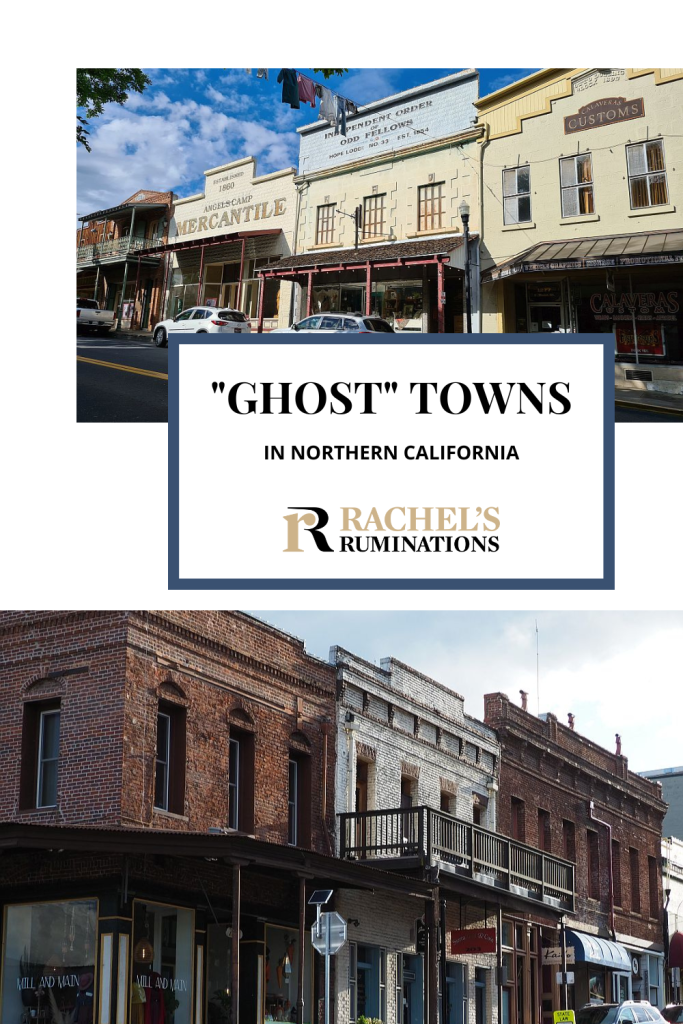Favorite ghost towns in California
After the discovery of gold in 1848 at Sutter’s Mill in Coloma, California, the California Gold Rush started. Thousands of people rushed to California, hoping to make a quick fortune.
Generally, they didn’t. In each place where a prospector found gold, more prospectors would swarm in, only to move on again when the gold find played itself out.
Disclosure: This article contains affiliate links. If you click on one and make a booking, I will receive a small commission. This will not affect your price.
Where gold was found, towns appeared, often within a matter of a few months. Sometimes new arrivals lived in tents, but entrepreneurs very quickly built banks, hotels, restaurants, saloons, hardware stores, general stores, and so on to cater to these new and transient populations. As a matter of fact, these entrepreneurs were the ones who really struck it rich in the Gold Rush.
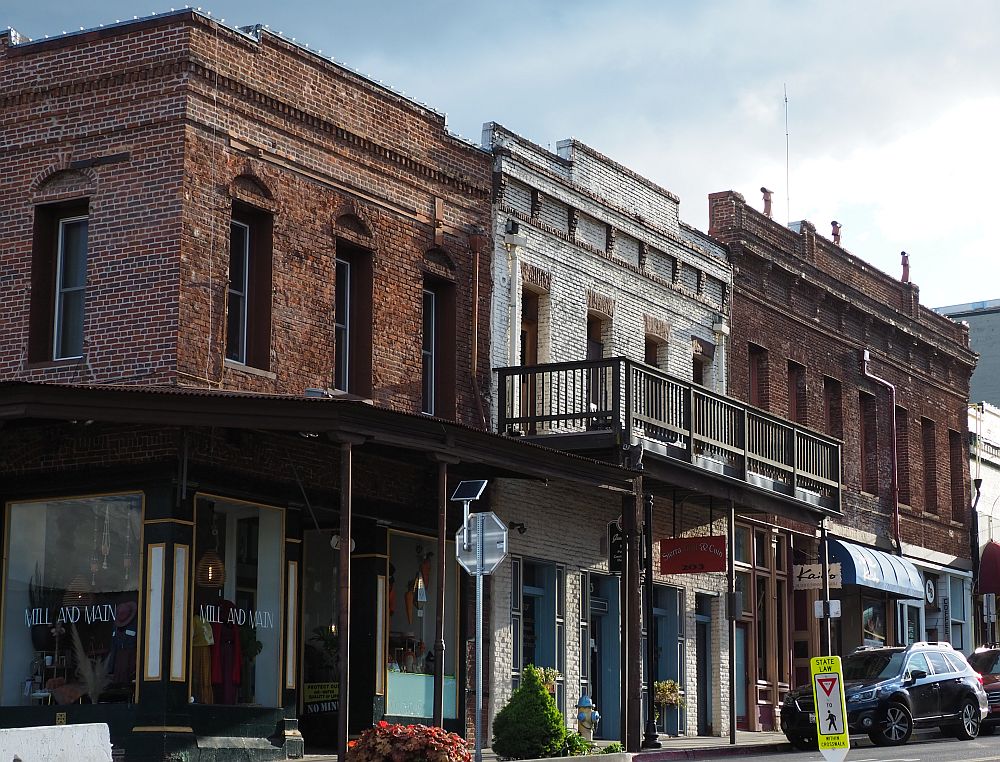
They built solid buildings in the dominant style of the American West: brick or stone, and many included a roofed walkway in front, sometimes with a balcony above it. Often they added a false front to make the building look bigger. For housing they mostly used wood, something that was plentiful in California.
Yet few of these towns lasted. When the gold seekers moved on to another rumored find, some of these towns just died. Sometimes their decline happened within 10 years of their founding. Others managed to survive, especially if gold mines were established, or hydraulic mining techniques were used. Of course, in those cases, the people who’d come in the hope of getting rich instead found themselves merely wage-earners.
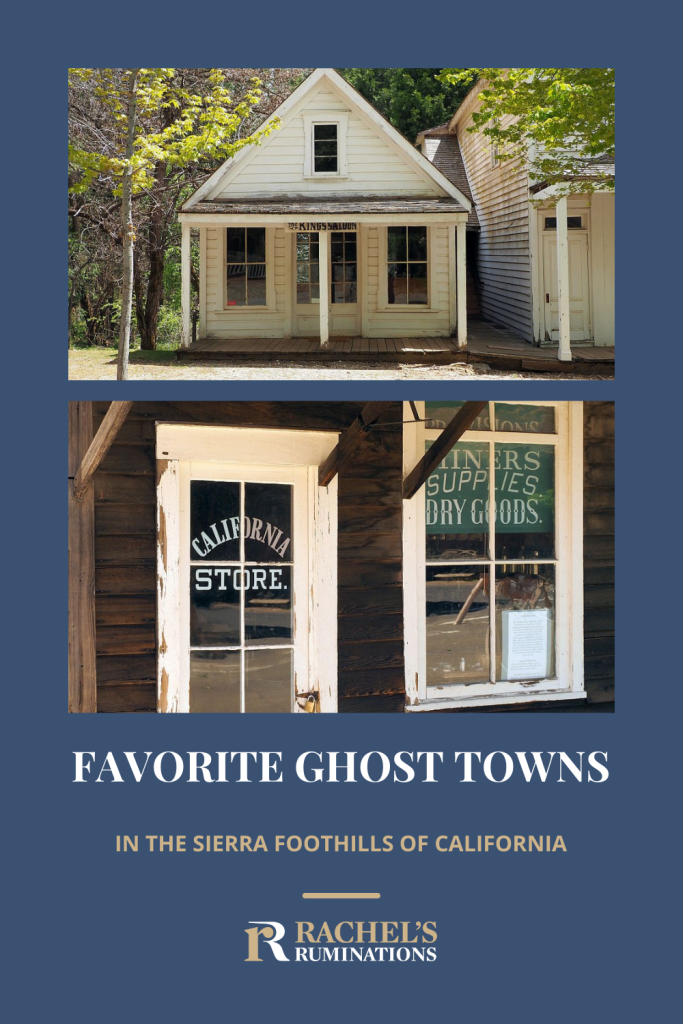
Ghost towns in California’s Sierra
Many of these towns still exist today in the foothills of the Sierra Mountains: places like Grass Valley, Nevada City and Placerville. Today they are picturesque and often touristy, with gift shops, wine bars and restaurants to cater to weekend tourists. The development of vineyards and wineries in the area has made it a chic destination as well.
Book accommodations in Grass Valley, Nevada City or Placerville.
Their history is easy to see just by walking along Main Street – it seems to be called Main Street in most of these towns. You’ll see at least one hotel: two stories, with a balcony along the upper story shading the wooden sidewalk along the ground floor. It’s likely to still be a hotel to this day. Other buildings now holding gift shops, restaurants and bars show their age in their uneven brick, false fronts, and – more precisely – in plaques explaining their history.
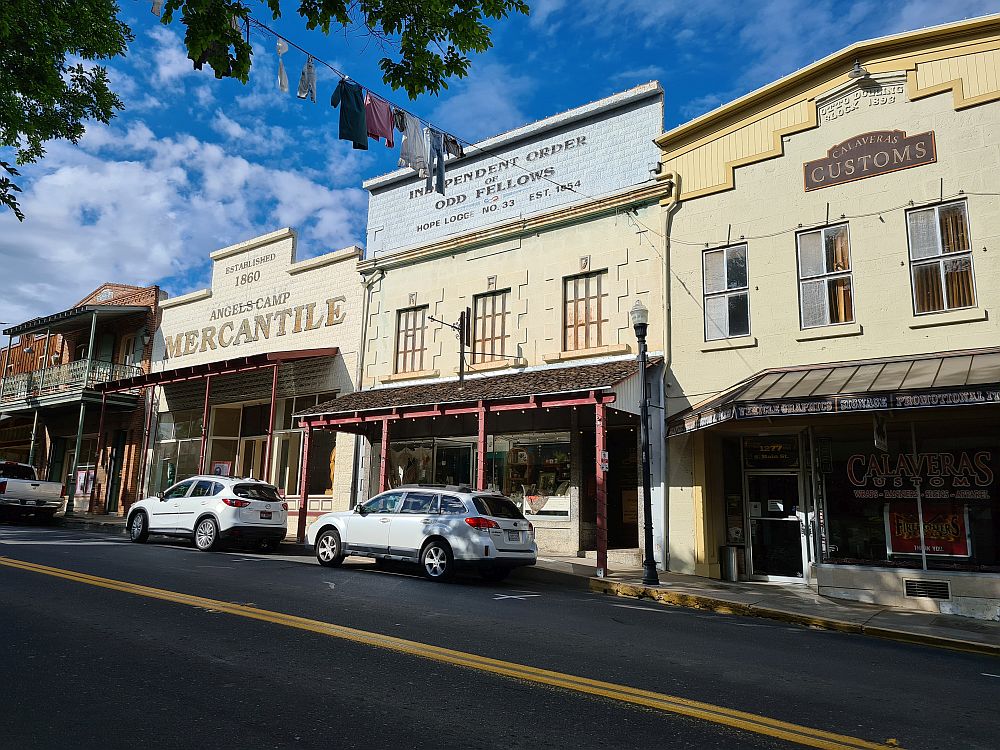
So these are not ghost towns. People still live and work in them, and the Gold Rush-era buildings are in good condition.
Yet, in a way, you could argue that they are ghost towns. After all, they still carry the history of this chaotic time, of all of those new arrivals who came with such dreams and left again, most likely disappointed.
Looking for California ghost towns
My daughter and I recently spent a week visiting many of these towns in the Sierra Foothills, ostensibly searching for ghost towns. While the vast majority of the places we visited were still living, breathing towns, we did find a few that I would characterize as true ghost towns.
1. North Bloomfield
North Bloomfield’s original name was Humbug – and my daughter and I agree that that was a much better name for a town. Founded in 1852 after gold was discovered nearby, it didn’t have the huge burst of arrivals that many of these new towns had. That didn’t happen until the Malakoff Diggins mine opened in 1860, but even still the population only reached about 2000 before the mine closed in 1883.
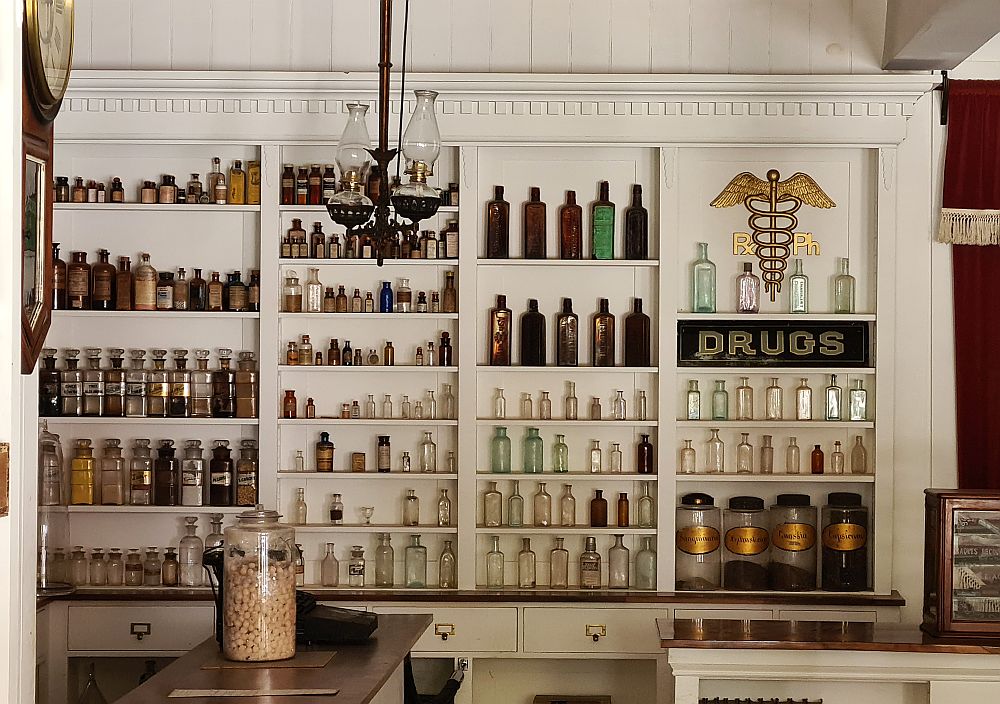
Malakoff Diggins
Malakoff Diggins was not just a mine. It was a hydraulic mine. Hydraulic mining was particularly intense. It involved blasting hills with high-pressure water and processing the resulting gravel and sand to find the very small percentage of gold it carried. Sometimes the companies added mercury to bind with the gold.
Hydraulic mining had far-reaching effects. The sand (and mercury) would wash away into streams. The streams silted up far downstream as the sand and gravel settled, often changing the stream’s course in the process. This caused floods in downstream towns, including Sacramento. Flooding and gravel deposits ruined huge amounts of farmland. Even San Francisco Bay began to silt up.
In an 1883 lawsuit brought by farmers against the mining company, hydraulic mining became illegal because of the environmental damage it caused. Malakoff Diggins closed down.
Today, at Malakoff Diggins State Historic Park, you can still see some of the effects of this form of mining. A huge canyon blasted out of the ground gapes, its scoured rock sides still brightly visible. The trees that have managed to find a place to root at the bottom are quite small, showing how slow the land’s healing is a hundred and fifty years later.
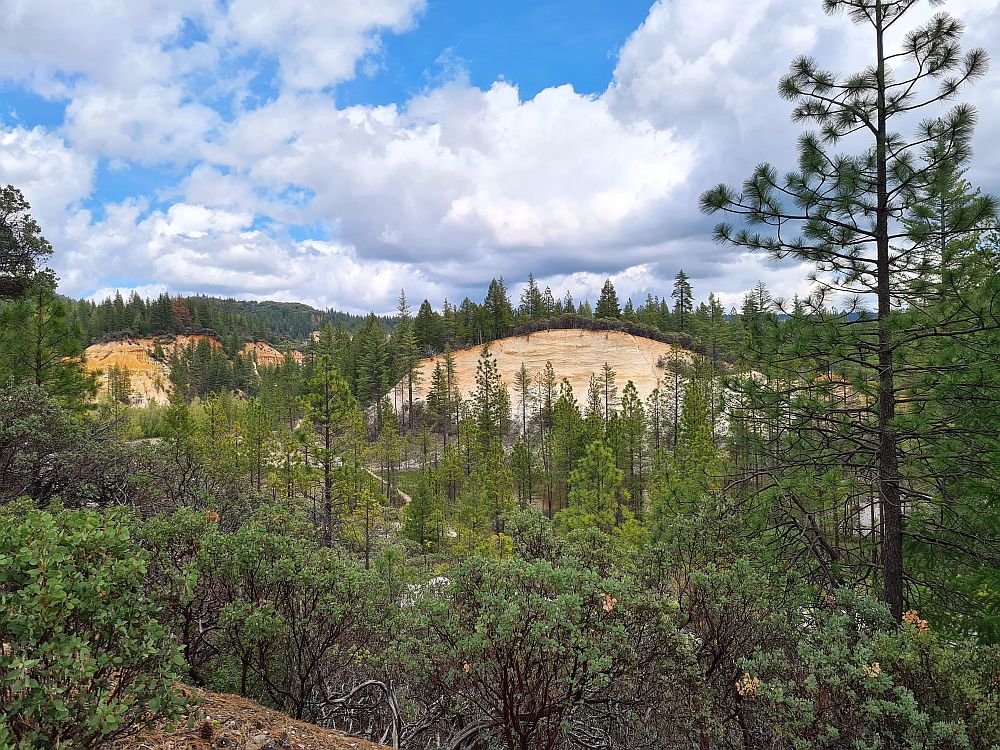
The North Bloomfield ghost town
The town of North Bloomfield is inside Malakoff Diggins State Historic Park. A few structures from the mine’s heyday remain standing, though many buildings have long since disappeared. There are several houses, a barber shop, a general store, a drugstore, a church, a schoolhouse, and so on. They’ve been restored and furnished to period. While people live in most of the remaining residences, the former businesses are now a museum. In the summer months you can take a tour through some of them, but the rest of the year you can only peer into the windows. Note: don’t look into the windows of the houses with white picket fences around them – these are still occupied.
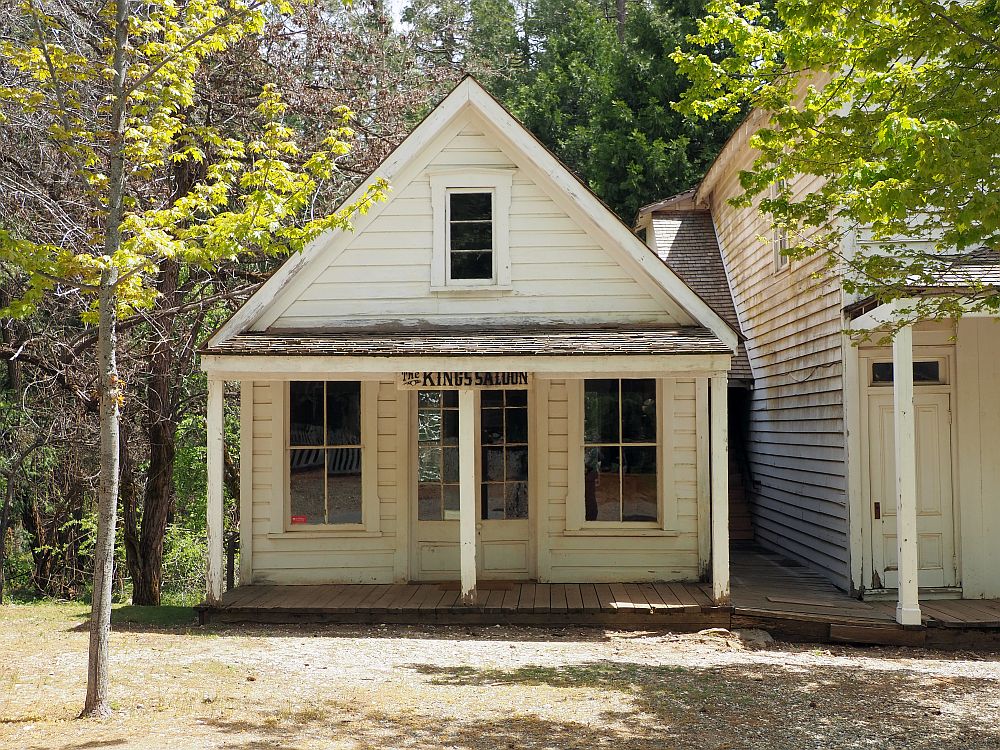
Malakoff Diggins State Park, where North Bloomfield is, is north of Sacramento. It’s about a 40-minute drive north of Nevada City on Coyote Street, then North Bloomfield Road, which winds its way into the hills. This road is closed in winter.
Book accommodations near Malakoff Diggins.
Malakoff Diggens State Historic Park: 23579 North Bloomfield Road, Nevada City, CA 95959. Open daily sunrise to sunset. Visitor’s Center open Thursdays 12:00-16:00 and Fridays and Saturdays 10:00-16:00. Admission is free to the park, but parking is $10 during the summer and $5 the rest of the year. Website.
2. Columbia
Founded in 1850, Columbia’s population grew quickly to 5000 people, according to Wikipedia. Six blocks of the town burnt down in 1854 and were rebuilt in brick, and that section of town survived after another fire burned almost all of the rest of the town.
By 1860 the gold was almost used up. Some was still found within the town itself, and the effort to reach that gold is still visible in the large rocks you’ll see scattered around the town. They’re what remained after miners hydraulically blasted the soil around them looking for gold. The town declined in population and importance until the creation of Columbia State Historic Park in 1945.

Unlike North Bloomfield, Columbia plays much more on its “Old West” appearance. The original brick buildings still stand – shops, houses, hotel and all – fully restored to their former glory. Some are occupied by a business catering to tourists in an “olde timey” style, with shopkeepers and park employees dressed in 1850s fashions. The grocery, for example, looks like it might have looked in those days, but has modern products – though some products hearken back to historical periods. Other buildings are museum pieces, set to look like they would have in Columbia’s heyday.
This place is popular, and if you visit on a weekend with good weather like we did, you’ll face crowds. Nevertheless, walking down the main street of the town, still unpaved and closed to traffic, you can get a clear idea of what the town might have been like in the 1850s. The arrival of an actual stagecoach drawn by four horses, pulling up in front of the historical Wells Fargo building, really adds to the ambiance.
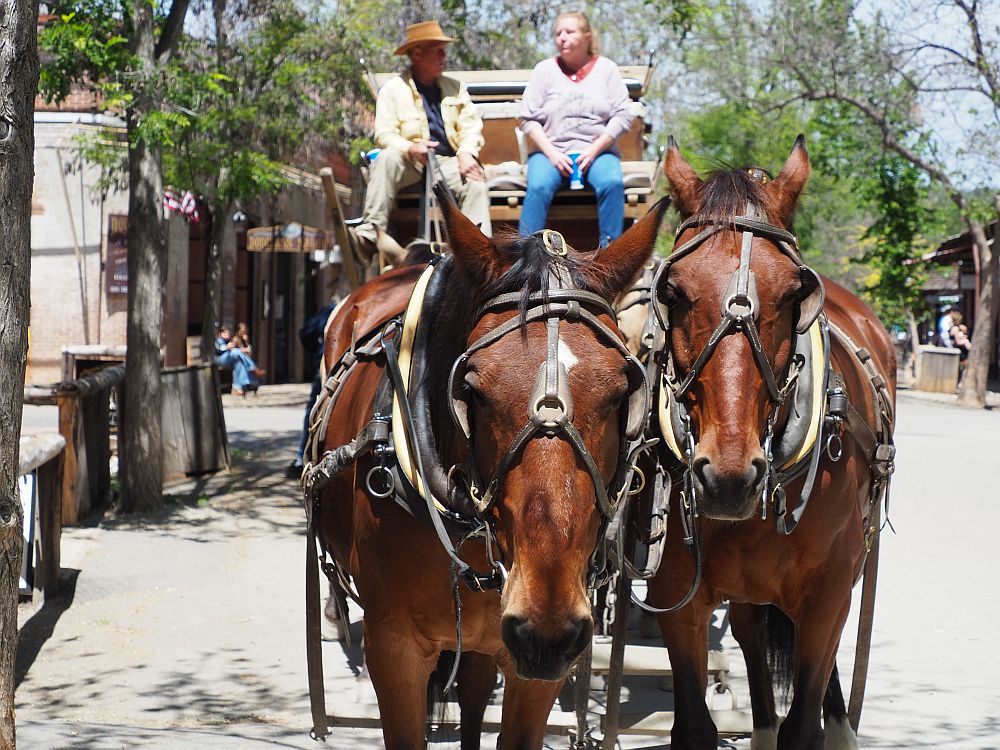
If you’re traveling with kids, Columbia is a great choice. There’s a working blacksmith shop, candle-dipping, candy stores, gold panning, a blacksmith, and the stagecoach. While walking the streets and entering shops is free, some activities charge a fee.
Some of the historical buildings are a bit outside the center of town, so take a stroll on the side streets to admire the old houses. Some are still lived in; stay out of the yards. On a small hill above the town, you’ll see the schoolhouse. Furnished to period, it gives an idea of what school might have been like in Columbia’s early years (cold and echoey!).

While I’ve never done this, despite several visits to Columbia over the years, I bet it would be really atmospheric to stay in a hotel in or near Columbia and to take a walk around in the cool of the evening, when the day visitors have all gone home. Book a hotel nearby.
Columbia is off Route 49. If you’re following Route 49 south, the turnoff is about five minutes past Tuttletown. Take a left onto Springfield Road and you’ll find Columbia after you pass through tiny Springfield.
Columbia State Historic Park: 38.0364 / -120.4003. Open daily. Most businesses are open 10:00-17:00. Admission free, though some activities charge fees. Website.
3. Chinese Camp
Chinese Camp was the only ghost town in the Sierra Foothills that we visited that felt like a true ghost town. Its few remaining structures are clearly not maintained in any way, slowly decaying and, in some cases, collapsing.
Chinese Camp got its name because the miners here were Chinese immigrants who worked for a group of Englishmen, according to a plaque on one of its remaining buildings. Established in 1849, it quickly grew to a population of about 5000 Chinese residents. It thrived for a long time, by Gold Rush standards: into the early 20th century. Once the gold dried up, it declined.
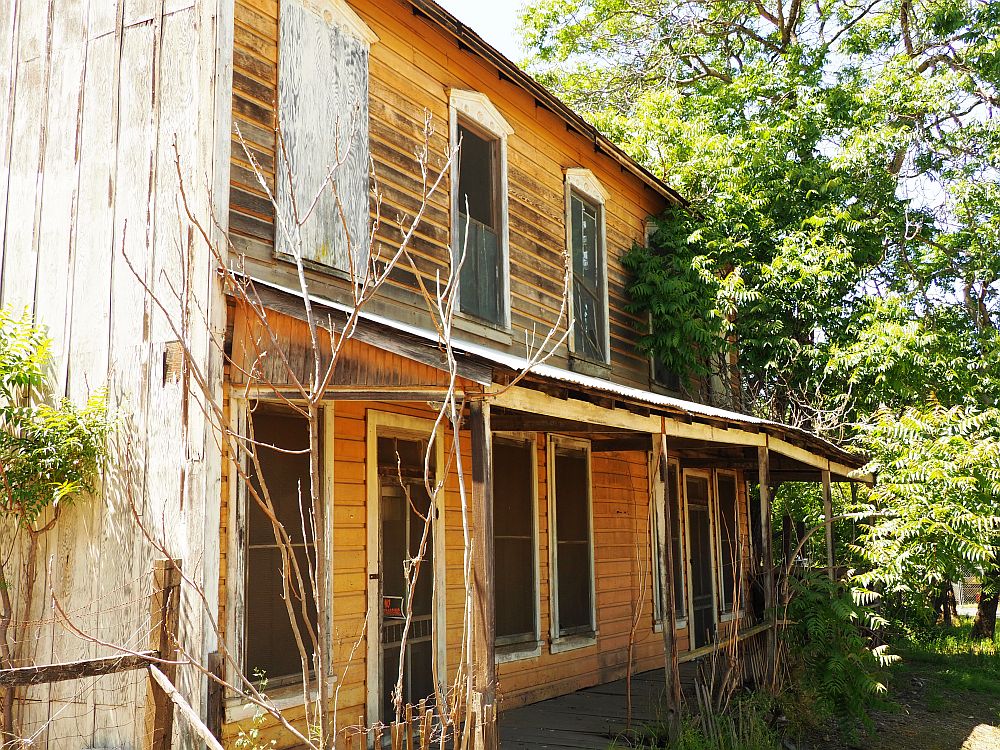
Today there are only fewer than a hundred residents. Yet I call it a ghost town because of a single block of what is still called Main Street. There, a few abandoned original structures remain. Most are wooden and were homes, a few of them quite substantial.
A single-story brick building still stands, shuttered tight, but the fittings on it – an old air conditioning unit in the window, for example – show that it was in use for something or other relatively recently. It was the town’s Wells Fargo Express Company building and it’s now a state historical landmark. A plaque commemorates the last of the stage drivers.
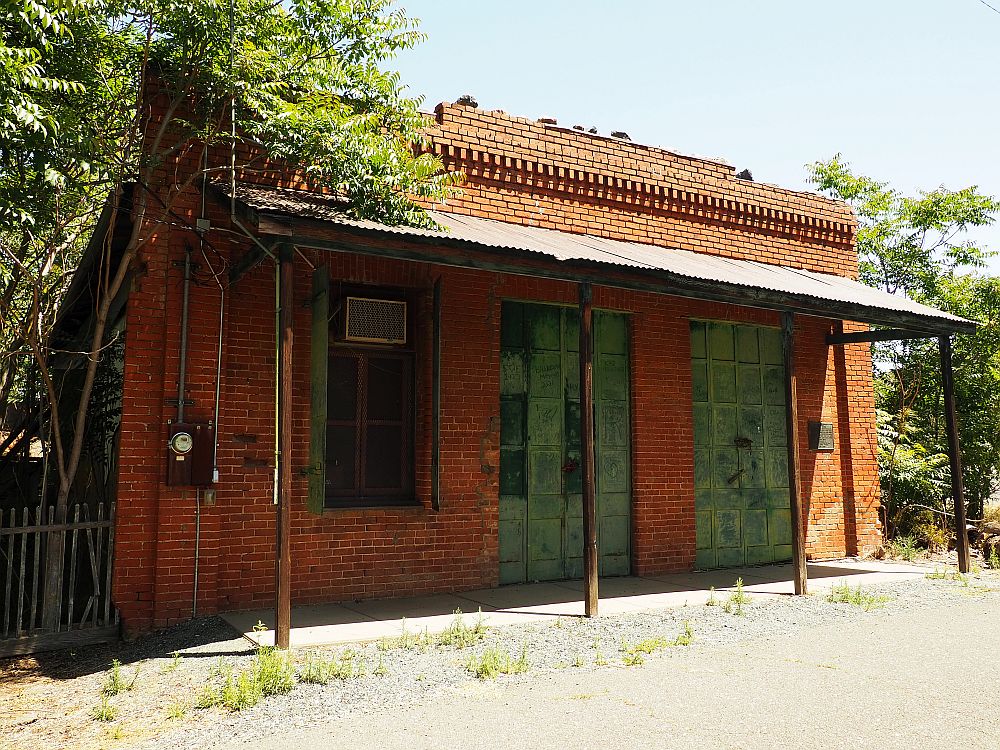
The town’s post office of brick and stone also still stands and dates to 1854, according to its historic landmark plaque. The plaque mentions a tong war that happened nearby – apparently the first in the US – between the Sam Yap and the Yan Woo tongs.
It’s not clear why this single block has been so thoroughly abandoned, other than installing a few plaques – the last one in 1961. Is there a dispute over ownership? A plan to tear the collapsing buildings down? A battle with preservationists? I don’t know.
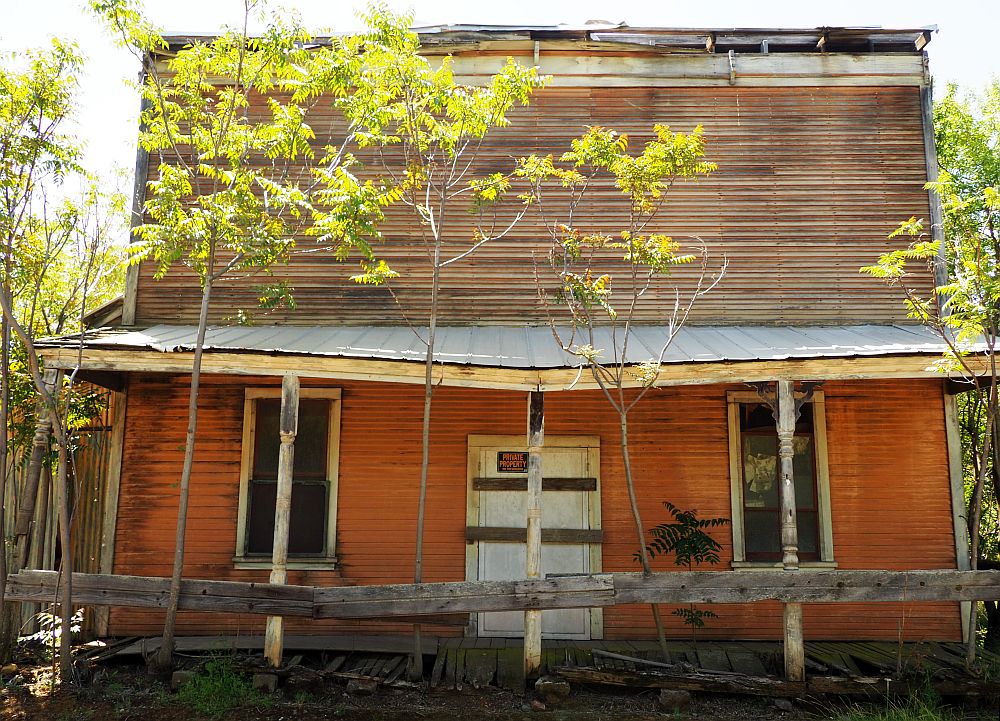
It’s a quiet place. It may be called Main Street, but there are no residences or shops in this block. We only saw one other couple of sightseers like us, but no locals.
Jamestown is the nearest real town to Chinese Camp. Chinese Camp is where Route 49 meets Route 120.
Book accommodations in Jamestown.
Chinese Camp: The few remaining buildings are on Main Street between Route 120 and Red Hill Road. The street is always open, but the houses are clearly posted with “No Trespassing” signs. No facilities, no admission fee, no website.
Of the three “real” ghost towns we visited on this trip, I think Chinese Camp was my favorite. It had that quiet, sad air of a true ghost town.
You might also enjoy my article “Two pearls of the California mission system” or any of my articles about sights in San Francisco.
Bodie
I have to mention one other ghost town because it’s long been my favorite. Bodie is not in the Sierra foothills like these other three. Rather, it’s on the other side of the Sierra mountains, between Yosemite National Park and the border with Nevada.
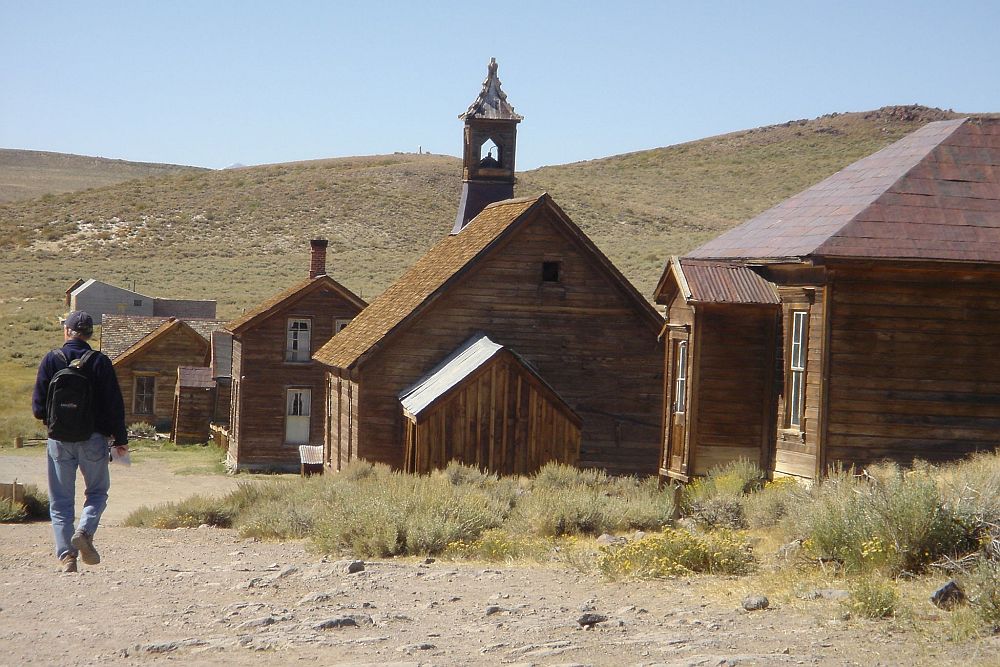
While Bodie was founded in 1859 after gold was first discovered there, it didn’t really take off until after 1876 when richer deposits were found. It grew to possibly as big as 10,000 people. By the 1880s, miners were moving away, and by 1910 only a few hundred people still lived there. Eventually it emptied completely.
Here’s why Bodie is my favorite: it’s a State Historic Park now, and the policy is to keep its remaining 110 structures in a state of “arrested decay.” This is a midway point between the renovation and repair that’s visible in North Bloomfield and Columbia, and the complete abandonment of Chinese Camp. The buildings are supported, for example, so they don’t cave in, but they’re not repaired any more than necessary to maintain the status quo.
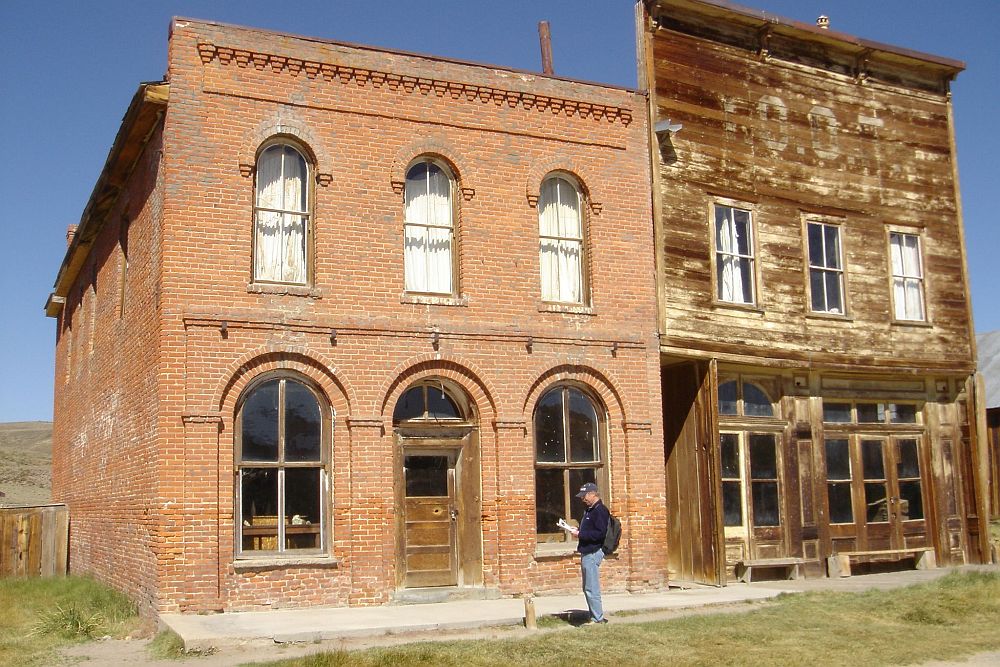
Visitors can’t go into most of the buildings, but they can peer in the windows. The interiors have been left as they were. Metal bed frames remain, wallpaper peels from the walls, and you can easily visualize how residents used these rooms. The site is open and treeless, increasing the eerie feeling as the wind sweeps the dust from the roads.
The park offers tours in the summer through the one remaining mill. Wear good solid shoes and bring a jacket or sweatshirt; even in the summer it can get cold at this elevation.
Book accommodations near Bodie State Historic Park.
Bodie State Historic Park: Open daily 8:00-18:00 from Memorial Day to Labor Day and the rest of the year 10:00-15:00. The hours can change, though, depending on weather and staffing, so check their website. The last 13 miles of road from Route 270 to the park do not get plowed, so don’t try it if you don’t have a four-wheel-drive vehicle with snow tires! Admission: Adults $8, Children 4-17 $5. Website.
Favorite ghost towns in California
So which would I recommend? All of these ghost towns are fun to visit. You could certainly visit Chinese Camp and Columbia in a single day; they’re only a half-hour apart. Malakoff Diggins, though, is 3½ hours further north, so it would be pushing it to try to see all three in a single day.
Malakoff Diggins/North Bloomfield is probably only worth visiting – unless your special interest is mining – when the buildings are open for touring, which is mostly only in the summer. Check their website.
Columbia would be my first recommendation if you’re traveling with children; it’s very kid-friendly. Be prepared, though, to spend some money on “penny” candy and various activities like riding the stagecoach or candle-making. With kids, Columbia could be a full-day visit.
Chinese Camp has no facilities; it’s just some dilapidated buildings along a road. Visiting would take a half-hour at most, just to take some pictures.
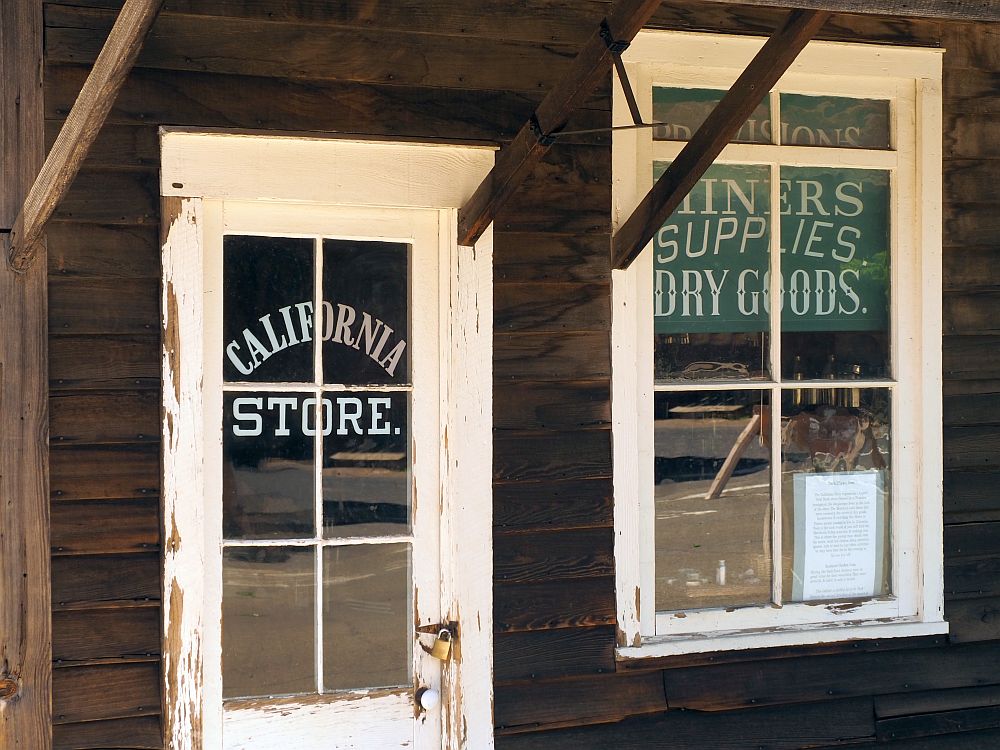
My favorite is still Bodie. It’s a fascinating place, as if time just stopped when the last miners left. Kids would enjoy peering into the windows, and perhaps learn a bit about mining at the same time.
Places to learn about California gold mining
A good place to start a road trip to see the ghost towns along Route 49 would be Marshall Gold Discovery State Historic Park in Coloma. It is in the place where Sutter’s Mill stood, where gold was first discovered, setting off the Gold Rush. It’s a great place to learn the history of the Gold Rush. It helped me to understand the different ways prospectors and, later, companies extracted gold.
What I had always pictured as just panning for gold in streams was just the start. In some places miners, working for mining companies, dug into hillsides to extract rock. Then they “stamped” the rock – i.e. crushed it – using a machine called a stamp mill to find any gold that might be inside it. And, as I explained above, hydraulic mining became the method of choice in some places. This park also includes some exhibits about the Native Americans who lived here originally, and about the Chinese immigrants who came during the Gold Rush as well.
In Grass Valley there’s another State Historic Park called Empire Mine. This mine was in operation for 100 years or so and is now a museum. The mining company offices and other mining-related buildings still stand. Tours and hiking trails are available.
Another place to learn about the Gold Rush and gold mining is Gold Bug Park and Mine in Placerville. Here you can walk into a mine shaft and learn about the lives of miners using an entertaining audio guide as you walk. There’s also a stamp mill to tour and, like at Columbia, the opportunity to pan for gold or watch a blacksmith at work.
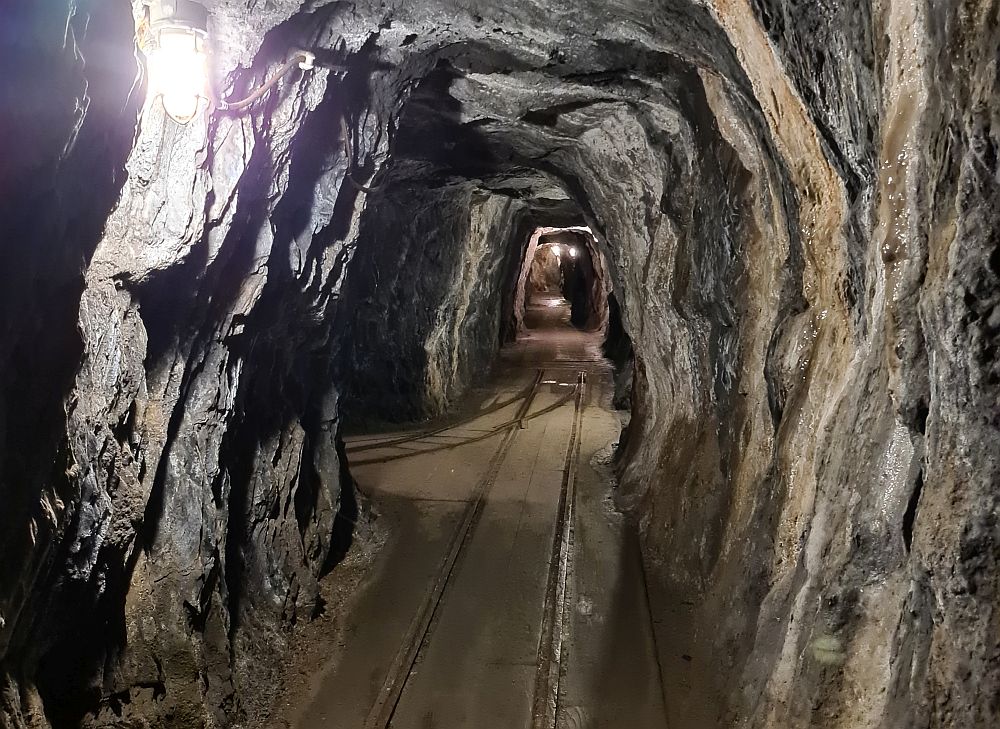
Where are the Gold Rush towns?
Many of the Gold Rush towns in California are along the aptly-named Route 49, which runs north-south along the Sierra foothills. Really the only way to see more than one or two is by car.
Compare prices and book your rental car here.
Map of California ghost towns
The map below shows all of the locations mentioned in this article, whether they’re “real” ghost towns or not.
It does not show every location where there are historical buildings in this part of California. They’re everywhere, especially along Route 49. Take your time and stop at the smaller towns that you might notice along the way. Sometimes there are just a few historic buildings, sometimes just a single abandoned building along the road. You could leave it up to chance, or download these audio tours if that’s more your style:
- This audio tour covers the drive from Auburn to Placerville.
- And this audio tour covers Placerville to Jackson.
- For the Jackson to Angels Camp section, listen to this audio tour.
Planning a trip to the California ghost towns in the Sierra foothills
A weekend trip to Malakoff Diggins
If you go to Malakoff Diggins, you could combine your visit with a number of other sights in the area in the space of just a few days. Nevada City is worth a stop. Grass Valley, just south of Nevada City, has a particularly charming street off Main Street that, when we were there, was pedestrian-only and very pleasant for strolling and window-shopping. We stayed at the Sierra Mountain Inn, which was walking distance away and very comfortable. Grass Valley is also home to the Empire Mine.
Auburn, south of Grass Valley on Route 49, is another cute historic town. Further south, Placerville is bigger and also quite charming, with more great shopping and strolling possibilities. The Gold Bug Mine is in Placerville, and Marshall Gold Discovery State Park is between Placerville and Auburn.
Book accommodations in Grass Valley, Nevada City or Placerville.
A weekend trip to Columbia and Chinese Camp
If your focus is further south, to see Columbia and Chinese Camp, you could combine your visit with a number of pretty Gold-Rush-towns-that-are-not-really-ghost-towns along Route 49 from east of Sacramento – which has a charming Gold Rush-era historical center of its own – and south from there. Many are worth a stop: Sutter Creek, for example, or Mokelumne Hill. We stayed in the original Main Street hotel – Leger Hotel – in Mokelumne and it was atmospheric, to say the least; let’s just say it would not surprise me if it had a resident ghost or two. Angels Camp is another lovely town too.
Book accommodations in Sutter Creek, Mokelumne Hill or Angels Camp.
A weekend trip to Bodie
Bodie is about three hours from Chinese Camp with Yosemite National Park in between. It would work well on a weekend trip when the road is open: Chinese Camp to Yosemite to Bodie. The same goes for a weekend at Mono Lake: Bodie is only about 45 minutes from there.
There are two ways to get from Chinese Camp to Bodie, both of which are closed from October or November to May or June, so they’re only an option in the summer!
- Route 120 is the route through Yosemite, and it continues to the other side of Yosemite until it ends at Route 395. Turning north on Route 395 will take you to the turnoff for Bodie at Willow Springs.
- The other option, avoiding Yosemite, is to take route 108. Then turn south on Route 395 until the turnoff at Willow Springs.
From the turnoff, ten miles of the road is paved, but the last three are unpaved. If you want to travel when the roads are closed, your only option is via Reno, Nevada to Truckee, California, then up to Bodie. Check Bodie’s website to make sure they’re open!
**This 4-day, 3-night tour includes Yosemite, Mammoth Lakes, Lake Tahoe, and a stop at Bodie.
**This 5-day, 4-night tour includes Yosemite, Mammoth Lakes, Bodie and other sites, as well as a stop at Bodie.
Have you been to any other ghost towns in California that you’d recommend? Please add a comment below!
